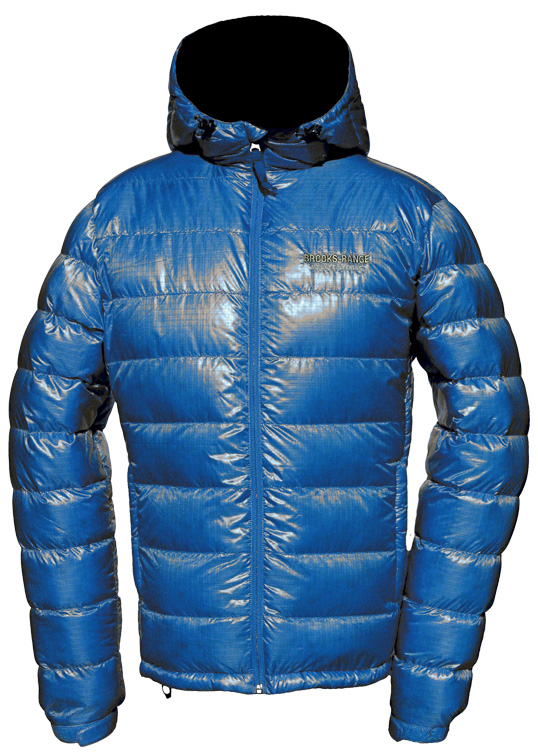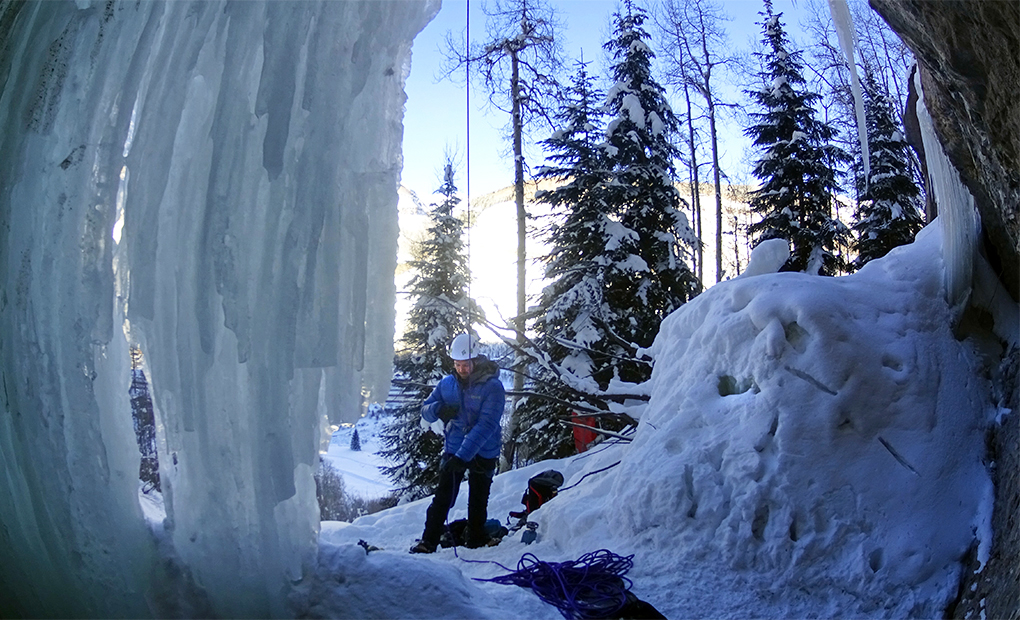
Brooks-Range Mountaineering Mojave Down Jacket
MSRP: $300
Reviewer Info: 6’3″, 185 lbs.
Size Tested: Large
Specs / Features:
- Insulation: 800+ fill power DownTek treated goose down
- Fill Weight: 6oz
- Stated Weight: 16oz
- Shell Fabric: Pertex Quantum Ripstop
- Lining: 20 denier Nylon
- Attached hood
- Baffled chest construction
- Zipper chin guard
- Low bulk cuffs
Days Tested: 20
Locations Tested: Rocky Mountain National Park; Summit County, CO; Vail, CO; Red Rocks, NV; Indian Creek/Moab, UT
Brooks-Range Mountaineering is a California-based company that finds their niche in mountaineering and backcountry travel. Their gear is tailored to winter use and high altitude ascents / descents in alpine style. Brooks-Range makes lightweight tents and tarps, some snow and avalanche equipment, and a range of apparel including down and synthetic insulated jackets.
The warmest of Brooks-Range’s outer layers is the Mojave: a simplistic down jacket insulated with 6oz 800+ fill DownTek treated goose down.
Fit
I’m tall (6’3”) yet relatively thin (32/33” waist), so it can be tricky finding clothes that fit me really well. But I wear a size Large in most things, yet I was still a bit surprised at the cut of the Mojave in a size Large. Namely, the torso of the jacket is a little more voluminous than is ideal for me. I probably could do with a size Medium in the jacket when it comes to the fit through the chest, but I worry that the sleeves of a Medium might be a bit too short, as the sleeves of the Mojave in a Large fit me perfectly.
The extra room through the torso of the Mojave isn’t too noticeable when I’m out climbing and wearing other layers underneath, but at times I felt like I was losing some heat due to the extra space air inside the jacket. I don’t necessarily consider this a strike against the Mojave; it’s a complaint we’ve had about similar jackets from Patagonia in the past, and you may not feel the same way about the fit of the Mojave. But I would check Brooks-Range’s sizing chart or try the jacket on before ordering, even if you’re used to getting the same size in almost everything.

Features
The Mojave doesn’t have a ton of bells and whistles, which I consider a plus. It’s got a solid zipper that doesn’t get stuck (mandatory), reasonably long sleeves, two fleece-lined front pockets, and drawstrings around the waist and hood. I like this approach to technical apparel: incorporate a small set of functional features, then leave it at that.
What is “treated” down?
If you’re new to “treated down,” DownTek is goose down feathers that have been coated with an extremely thin (on the order of nanometers) layer of polymer. Often called “cationic pretreatment,” the treatment process is also commonly applied to natural fibers like cotton and wool, in order to alter the surface energy of the fibers so that dyes will bind more effectively. (For those so inclined, a general discussion of this sort of treatment can be found in several industrial science journals.)
In the case of treated down feathers, the altering surface energy is not concerned with dyes, but as a way of encouraging a property called hydrophobicity—how effectively a material repels water. The more hydrophobic a material is, the more readily water will bead up and roll off, rather than being absorbed into fibers. This is a big deal with respect to down insulation which is is virtually useless when wet, as it loses its loft and ceases to provide warmth. Treated down seeks to combat this in making the down feathers hydrophobic, and thus better able to retain more of their loft when exposed to moisture.
The treated down used in insulated apparel and sleeping bags is usually made by one of two brands: DownTek (which the Mojave is filled with) and DriDown. DownTek is a third-party manufacturer licensed and used by companies such as Brooks-Range Mountaineering, Big Agnes, Mountain Hardwear, Millet, and others. DriDown, is used exclusively by Sierra Designs & Kelty. Comparing DownTek to DriDown falls outside of the scope of this review, but they are both claiming roughly the same specs: 30% lower water retention, and drying times that are 60% faster than standard, untreated down. A good discussion of the performance of DriDown insulation can be found in Matt Zia’s review of the Sierra Designs Zissou 6 sleeping bag.
Performance
DownTek Insulation in the Mojave
I was impressed by how well the Mojave retained its loft after a day of exposure to snow. I never soaked the jacket entirely through, but the shell fabric of the jacket was saturated, and the feathers inside were likely getting hit with some moisture. Given my experience (and Matt Zia’s experience with DriDown), I feel confident in saying the Mojave’s treated down insulation does perform better than regular down when it comes to dealing with moisture. Granted, It will still lose some loft when it’s wet, but not as much as untreated down, and since the technology comes with no real weight or warmth penalty, I can’t think of anything I dislike about treated down.

I have the non-hoody version from a few years back and it’s an outstanding down jacket! Very durable, I hardly see any down leaking, decent water resistant shell fabric! That’s my go to jacket for cold days around town, dinner, usually have it on my car if I’m resort skiing and want to be outside for apres
I wish brooks-range had an ultralight version to be used as a layer piece!
Between this and the mountain hardwear Nilas, which would you recommend? I’m hoping to use one of the two as my down puffy on the coldest days in Boston, MA, and on mountaineering trips (Rainer, for example). I’m not sure how the two compare warmth-wise, which is my largest concern.